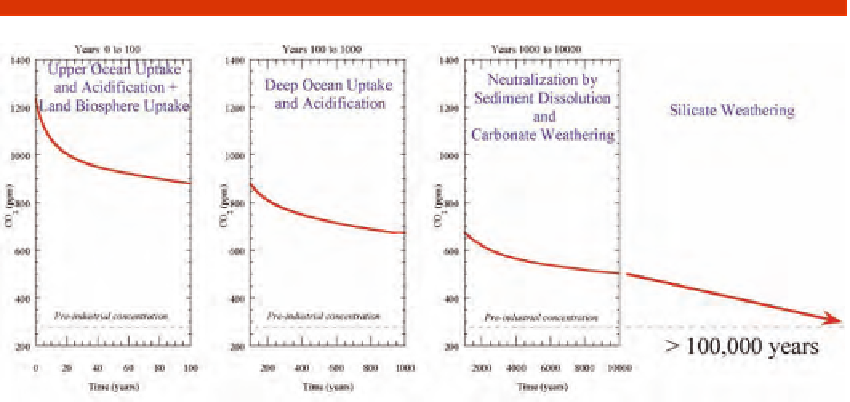Environmental Engineering Reference
In-Depth Information
BOX 2.2 TIMES CALES FOR REMOVAL OF CO
2
FROM THE ATMOSPHERE
The figures show the fate of a pulse of 2,600 Gt of carbon released instantaneously into the
atmosphere as CO
2
. In the first hundred years CO
2
is absorbed into the upper ocean. The resulting
acidification limits further uptake by the upper ocean waters. During this time period, there is also
typically some uptake by the land biosphere. In the next 900 years, the saturated upper ocean
waters mix with the deep ocean, allowing further uptake. Eventually, the deep ocean acidifies as
well, limiting further uptake. Over the next 10,000 years the ocean becomes buffered by dissolu-
tion of carbonate sediments and by carbonates washed in from land, reducing the acidity and
allowing the ocean to take up additional carbon. Over longer time scales spanning
more than
100,000 years, most of the remaining CO
2
is removed by reacting with silicate minerals to form
carbonates (e.g., limestone). We have not attempted to state the precise time required for silicate
weathering to cause recovery to pre-industrial values, because of uncertainties in silicate weath-
ering parameterization and uncertainties in the long term response of the glacial-interglacial
cycle. The only long-term sink of CO
2
is silicate weathering, which is a very slowly increasing
function of temperature. It would require over 20°C of warming to balance a steady state fossil
fuel emission of only a half Gt of carbon per year, so that even an emission as low as this would
lead to a steady accumulation of CO
2
in the atmosphere. This calculation does not allow for any
long-term net release of carbon from land ecosystems or marine sediments, though it is known
that the Earth system is capable of such releases. Any such release would increase the long term
CO
2
concentrations and delay the recovery to pre-industrial values. (Data up to 10,000 years
based on carbon cycle simulations of Eby et al. (2009). Silicate weathering time scale estimated
from data given in Berner (2004). See Archer et al. (1997), and Archer (2005) for more details on
the mechanisms of CO
2
removal.

